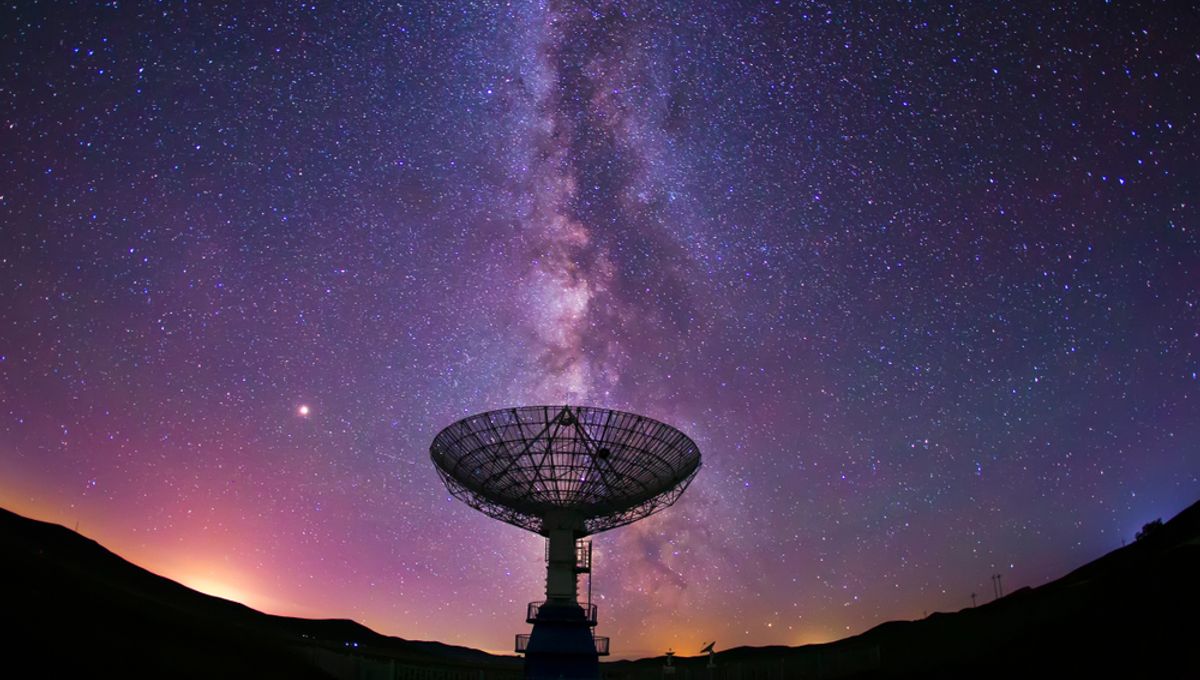
Bob Dorough believed that three is a magic number – but if astronomers were to pick one, they probably would choose 21. Not just any 21, but 21 centimeters (8.27 inches): a specific wavelength of light that can tell us much about alien life, the universe, and everything.
This type of light is in the radio wave part of the electromagnetic spectrum, produced by the transition between two energy states of hydrogen atoms, which are very close to each other. In its simplest form, the ground state, a hydrogen atom has a proton in its nucleus and an electron in an “s” orbital around it. Both particles have a quantity called spin. Their spin can either point in the same direction or in the opposite direction. The former has slightly more energy than the latter.
So, if a hydrogen atom has the spin of its proton and electron pointing in the same way, over time it will switch to the opposite state as it’s less energetic, and does so by releasing a photon. The wavelength of the photon is more precisely 21.106 centimeters. This is what we are looking at when we observe this line.
From the Milky Way To The Dawn Of Time
This line was a crucial step in the development of radio astronomy, as its presence in the sky sent astronomers on a quest to reveal its source back in the 1930s. It was not the Sun like it was thought at first – it was realized that it came from the center of the galaxy. It was first determined to be the 21-centimeter line or hydrogen line in 1951, and the first map of neutral hydrogen in the Milky Way was completed soon after.
By assuming that there is neutral hydrogen in every direction – a fair assumption given that hydrogen is the most common element in the universe – you can measure this line. However, given that the galaxy and the hydrogen within are moving, this specific emission will be shifted by the doppler effect. This is the same effect that causes the pitch of an ambulance’s siren to be higher when the vehicle is approaching.
Performing those measurements allowed us to understand the speed of structures in the galaxies. Astronomers were able to work out the spiral structure of the Milky Way with the 21-centimeter line. But this emission has even more astronomical applications: these radio waves are not absorbed by the large clouds of cosmic dust. They are opaque to visible light, but are transparent to these radio waves.
This light can also be used to probe the cosmic dark ages, the period between the emission of the Cosmic Microwave Background and the light of the first galaxies. During that period, all of the hydrogen in the universe was neutral as there was no light powerful enough to rip the electron from the protons. That will happen with the first star. Attempts to study this poorly investigated period have struggled so far, but it is believed that this will be a major area of investigation in the future.
Sizing Up Ourselves And Talking To E.T.
As radio astronomy was becoming a more important discipline, those radio dishes were also being used for the search for extraterrestrial intelligence (SETI). It is no surprise that this particular wavelength, a specific emission of the most common element, caught the eye of people interested in SETI.
One suggestion by Russian scientist Pyotr Makovetsky was that aliens might communicate on a frequency that was π times the frequency of the hydrogen line or twice that. These frequencies are not really busy, and they would be very distinct from natural emissions.
The hydrogen line was also used in our potential communication with alien civilizations. Both the pioneer plaque and the Voyager golden disk have this wavelength as the basic unit of length, which was used to describe how tall the average woman is as well as giving an approximate position of the Sun with respect to some nearby pulsars.
This special number has taught us much about the cosmos and clearly has the potential to tell us so much more.
Source Link: 21 Centimeters Has A Special Significance In The Universe